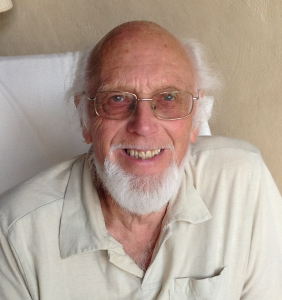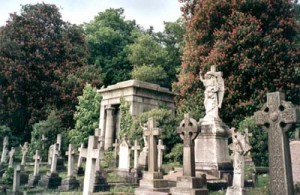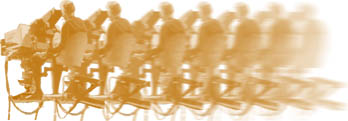PREFACE.
Once upon a time I read somewhere that if you start a story “Once upon a time” it has to have a happy ending. I’ve no idea if this is true and as I haven’t written this story yet I have no idea how it will end. So please come along with me and see where we get to.
CHAPTER 1
And so it came to pass that in the year of our Lord one thousand nine hundred and thirty two, in the Lodge at Handsworth Wood Cemetery, a baby boy was born to Florence & Richard Leighton.
You may well ask what is the relevance of the Cemetery – none really, it is just that my Father was Superintendent Registrar and the house was a perk of the job along with the occasional bottle of Scotch from grateful undertakers.Perhaps because my Mother liked Indian food (long before it became fashionable) I was named Clive. A name I have grown to like over the years.
Growing up in a cemetery was peaceful, the residents were all quiet and gave no trouble. I remember that we had fish & chips delivered every Friday lunch time, properly packaged in newspaper. A delicacy that I love to this day, particularly if it is Huss (Rock Salmon to the uninitiated).
When I was 5, my Father became Superintendent at the rather up-market Cemetery and Crematorium called Putney Vale near Roehampton in SW London. The residents there included Vesta Tilley, Howard Carter (Egyptologist), Kenelm Lee Guiness of KLG sparking plugs – in a plot overlooking his factory – and many more famous people.
The dark days of war came along. We were on holiday in Bognor Regis and I remember listening to the declaration of war in our B&B. Later my very worried parents took me to the high ground in Hastings and we could hear the guns from across the Channel. Back at home there was an Anderson shelter in the back garden and a quickly erected mortuary adjacent to the cemetery for the casualties of the expected bombing raids. This was quite fascinating to a 6 year old who watched proceedings from under a toy tin hat. After raids I would cycle around the Cemetery (before opening time) looking for nose cones from the AA shells. I had quite a nice collection until a cousin, who must have been around 9 at the time, thought I was ghoulish and threw them away. I have never forgiven him for this vandalism.
Wimbledon Common was adjacent to the Cemetery and many a happy hour was spent either wandering around exploring, and in the winter snow tobogganing down the steep slopes. Even more exciting was watching the soldiers trying to make log bridges on Queensmere lake. This usually ended up with the thing falling apart and the lads ending up in the water.
Further up the road was another lake, Kingsmere. In the summer I sailed my model yacht there and in the winter there was skating on the frozen lake. The Fire Service trained there. The firemen were blindfolded to simulate the blackout, and had to operate the pumps by touch, drawing water from the lake and drenching the unwary onlookers. And so I grew up watching the doodle bugs crossing the sky muttering, as I’m sure every one did, “keep going!” We were lucky, only had the windows blown in twice and a nasty smelly oil bomb in front of the house.
My poor Father was frequently called out by the police during the night, as lights had been seen in the Cemetery. The thought was that German spies were trying to access the KLG sparking plug factory adjacent to the Cemetery, perhaps with a view to sabotage as the plugs were for aircraft. Can’t imagine any saboteur walking around in the black out waving a torch around. Any way nothing was ever found, but it was exciting at the time. Eventually I found myself in grammar school where the staff were mainly retired teachers who tried their best to get us up to School Certificate standard. Not the happiest time of my life. I was glad to escape as soon as I could and went to work for the Ministry of Works at Hampton Court Palace. I also became involved with the local Operatic & Dramatic society. A most enjoyable time and I eventually ended up as stage manager! After a couple of years I received an invitation from the King to join the armed services for National Service.
CHAPTER 2.
The thought of 2 years in the Army was depressing, so taking advice from friends I volunteered for 3 years in the RAF. Not only was the pay better but I got to choose a trade. Looking at the list of trades, photography, radio & radar paid rather well. I was selected for training as an Air Wireless Mechanic. After 6 months training at RAF 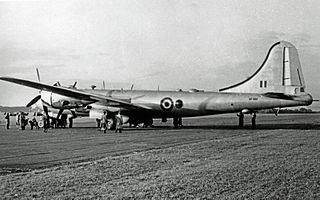 Yatesbury, I was fully qualified to work on any British aircraft. I was therefore posted to work on American B29’s (Superfortress) at RAF Marham in darkest Norfolk. At this time (1951 /52) the airfield was shared with our American cousins who took care of security with many machine gun and AA gun emplacements. There were armed guards with live ammo. Even the stores had two guards with loaded carbines outside. I really have no idea why they were there as the store keeper gave you anything you wanted.
Yatesbury, I was fully qualified to work on any British aircraft. I was therefore posted to work on American B29’s (Superfortress) at RAF Marham in darkest Norfolk. At this time (1951 /52) the airfield was shared with our American cousins who took care of security with many machine gun and AA gun emplacements. There were armed guards with live ammo. Even the stores had two guards with loaded carbines outside. I really have no idea why they were there as the store keeper gave you anything you wanted.
At night, if challenged, it was wise to hit the ground before replying. We British, who guarded our squadrons of Superforts, were issued with a dodgy torch and a chair leg on a piece of string. We never lost an aircraft, but our cousins had a depressing record of shooting at anything that moved resulting in the loss of several police dogs.
The terrible East Coast floods had the whole camp mobilised and were sent to fill sandbags 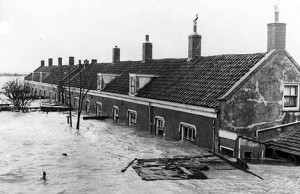 or give other help. We put an aircraft VHF and MF Tx/Rx into a signals wagon.
or give other help. We put an aircraft VHF and MF Tx/Rx into a signals wagon.
The radios were powered by a huge Superfort ground power unit towed behind the signals wagon, and we were able to liaise with HQ at Marham. When the emergency was over all weekend leave was cancelled because one shovel had been lost!!!
CHAPTER 3
Demob time……An old school friend had joined the Beeb and told me that “they” looked on ex RAF people favourably. So I applied and was given an appointment for an interview in Birmingham. I wrote and explained that to get from Kings Lynn to Birmingham I would have to go via London, so could an interview be arranged in London. I received a lovely reply giving me the train times to get me to the interview as arranged in Birmingham, The only problem was that these trains had not run since the war! Anyway I made my way to BM and duly had a very pleasant interview. I was asked my preference for departments. I gave Tel OB’s then Tel studios, Radio OB’s or Radio studios. After the interview, the SRE at Birmingham was standing by to rush me to the station to catch the non existent train back to Kings Lynn. A tiring but pleasant day.
Some weeks later I received an invitation to join Transmitter Department at Bartley, near Southampton. So much for my choices! Bartley was a 10kW medium wave transmitter radiating Basic A or Home service. There was a 2kW stand by transmitter powered by an antique Lister Diesel. Bartley also had remote control of low power TX at Brighton, Bexhill & Folkestone. Life there was pleasant. I had the use of the station bicycle which enabled me to see a bit of the New Forest. I learnt many useful things, e.g. how to boil 5 gallons of oil to top up capacitors and transformers, Megger the carboys of distilled water and how to climb into the roof space to top up the telephone batteries. Not to mention cleaning double enders!
I soon realised that the transmitter engineers were a very learned lot doing City & Guilds 5 or something incredibly clever. There was, I felt, little hope that I could match this to progress to grade C- so I applied to transfer to London studios. That is how I came to BH Control Room, which at that time was in the dungeons of BH. I had to learn the way in which programmes were distributed.The work was varied, one day checking every mic & mic point in every studio. Each gram deck was checked. The Teddy Bears Picnic was the record for the 78 decks & Peter & theWolf for the few LP decks. There were lots of double enders to be cleaned, especially the grey ones reserved for Grade 1 broadcasts.
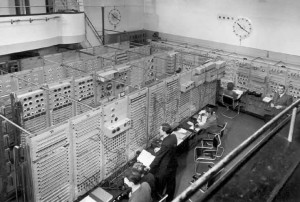 The programme routing was carried out in 3 main positions, Incomings, Outgoings & SB (Simultaneous Broadcast) On the balcony was OB’s. There was a row of bays which handled the routine connection of studios or external sources to recording channels etc. Control Room staff also operated the 3 Continuity suites, Home, Light and Third programmes. Eventually I was allowed to operate Third continuity as a meal relief. I enjoyed my time in Control Room but after a couple of years I heard that people were rushing from Lime Grove to join the ITV lot. Once again I applied for a transfer to TV. The EiC London station warned me against such a move as ITV would be a failure. If I stayed in the Control Room, one day I might reach C minus!! They must have been hard up as a transfer was granted very quickly and I soon found myself at Lime Grove.
The programme routing was carried out in 3 main positions, Incomings, Outgoings & SB (Simultaneous Broadcast) On the balcony was OB’s. There was a row of bays which handled the routine connection of studios or external sources to recording channels etc. Control Room staff also operated the 3 Continuity suites, Home, Light and Third programmes. Eventually I was allowed to operate Third continuity as a meal relief. I enjoyed my time in Control Room but after a couple of years I heard that people were rushing from Lime Grove to join the ITV lot. Once again I applied for a transfer to TV. The EiC London station warned me against such a move as ITV would be a failure. If I stayed in the Control Room, one day I might reach C minus!! They must have been hard up as a transfer was granted very quickly and I soon found myself at Lime Grove.
A spell in valve & camera tube stores convinced me that this was not for me. Then to film recording. Now that I thoroughly enjoyed and managed to stay there. I loved the smell & feel of film. (Not to mention the short ends!!) Exciting times recording sound & pictures on HP3! Also the 16mm recording from a commercial tv with added spot wobble not to mention the terrible variable density sound. This was later replaced by a Marconi Quick Pull Down situated in a large tin booth in the recording area. By chance I recorded the original rehearsals of the Queens Christmas speech which were duly sent for Royal approval.
This was originally an Engineering department but was made into an operational one. I went to Wood Norton to do the C ops course when we heard that Recording was going to revert to Engineering. I requested a transfer to the Engineering C- course but were assured that there was absolutely no intention of changing back to Engineering so stayed with the ops course. Having passed the course and returned to Recording we were told that we were all out of a job as the department was going back to Engineering!
CHAPTER 4.
So what then, find another job. We were told that we could choose any department we
liked, I asked for film unit. Had an interview for a trainee film cameraman but was
rightly beaten by Butch Calderwood. We were at Wood Norton together on a course
and he was always flashing his Bolex.
I was now told that I would have to go to TV studios. At long last!! As a raw recruit I
was given the opportunity to try my hand at various things. I was not allowed on a
boom after I nearly brained Valerie Singleton on Blue Peter. Cameras – reading a crib
card and trying to select the correct lens, point the camera in vaguely the right
direction and focus all the same time was another skill that eluded me. I have the
greatest respect for those that have this skill. 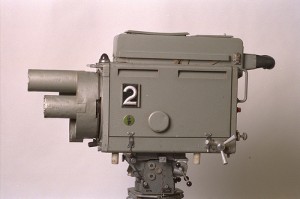 Vision control, CPS cameras & IO’s. Hands in CCU’s. This suited me. A wonderful time with a whole range of exciting live shows. B&W Minstrels, Billy Cotton BandShow, Crackerjack, Big Band shows, Pet Clark… I could go on – you name it we didit. The best job in the world. Didn’t dare to think of ten million plus people watching live shows!
Vision control, CPS cameras & IO’s. Hands in CCU’s. This suited me. A wonderful time with a whole range of exciting live shows. B&W Minstrels, Billy Cotton BandShow, Crackerjack, Big Band shows, Pet Clark… I could go on – you name it we didit. The best job in the world. Didn’t dare to think of ten million plus people watching live shows!
I probably turned John Summers hair gray when we were doing a live music show
with many lighting cross fades. I used “Rem Dim” with a stage weight on the floor
button. Bet they don’t do that anymore!
CHAPTER 5.
Colour came & I was lucky to be turned into a TM2. Even lit quite a few shows. Lots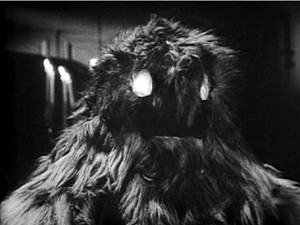
of Children’s programmes, Blue Peter, Playaway etc. The high spot was when Geoff
Shaw let me light a Dr Who, TheWeb of Fear.
TheTM’s office was conveniently situated next to the tea bar. To start the day there
was nothing better than a coffee and one of Jackie’s sausage rolls heated to greasy
perfection on top of the hot water boiler. Unfortunately, the health police eventually
stopped this and breakfast was never the same again.
My first solo as aTM2 was in TC1. Not Only But Also. Pete & Dud. A whole string
of the very best comedy & music shows followed, most of which I have forgotten.
How I wish I had kept my diaries.
Time passed, TM’s were turned into TC’s and I had to say goodbye to lighting.
Never mind, Plenty of wonderful shows. Lots of children’s programs. Lots of TOTP,
outside rehearsal & snacks with Flick and Pans People. Cant get much luckier than
that!
I well remember a planning meeting with Walter Todds at Ken House. During the
meeting I noticed smoke coming from Geoff Shaw’s jacket pocket. His slumbering
pipe had set fire to his jacket. Geoff quickly put out the fire but not before the office
was a bit smoky. A window was opened and a gale blew in, quickly clearing all the
desks of paper. Luckily the fire alarms and sprinklers did not go off.
I had to spend a few weeks lighting the OU productions at AP. A very relaxing time.
I caused a bit of a stir when I asked the sparks to rig a couple of Pattern 23’s with holes
poked in tin foil. The intention was to break up a boring plain backing. Cue the
director who arrived and threw a wobbly! Never been done before…distracting…. not
suitable for an educational programme etc. I explained that as the programme was
being film recorded, the broken up background would minimize the inherent noise in
the system. Rehearsal was delayed while the suits withdrew to hold a meeting! Eventually thisrevolutionary idea was reluctantly accepted.
A thoroughly enjoyable spell at the Greenwood. Superb food in the canteen, and a
great selection of shows. Russell Harty, Parkinson, Question Time and Friday Night Saturday Morning.
A bomb scare and we had to evacuate the place. A rather large Sergeant of Police
offered me the opportunity of searching the place. (He explained that he did not know
the lay out of the theatre, I explained that I didn’t know what a bomb looked like. He
said that neither did he!) So I persuaded a couple of “Volunteers” to help but luckily
we found nothing.
Then there was the day when we lost the vision circuit to TVC just before a
recording. It eventually turned out that a Post Office Engineer in a repeater station
turned off ALL the power as he was going home. Poor audience left not knowing
what was happening. (Neither did we!) Bill Poole arrived and we rang just about every TV organisation we could think of to try and get a mobile VT unit to come over, but none to be had. Eventually power was restored and all went well.
CHAPTER 6 and last!
Time passed and I sort of volunteered for sport. This was, at times, a 7 day a week
job with very long hours. It was a good team. Paul Mason, John Carter, Tony Bate,
Rod Litherland & Ken Morris. International sports, Commonwealth Games,
Olympics. Motor racing on a Sunday afternoon, gallery only. Murray Walker plus
guests. Cricket on BBC2.. You name it, the Beeb covered it. Exciting times in the
Gallery, not quite as noisy as in the Cowgill days but it had its moments!
I managed to get involved with a few Christmas specials, TOTP and Morecambe &
Wise. I was at the studio end of LiveAid and a Christmas day special with Noel Edmonds up the Post Office Tower.
All good things have to come to an end, One morning around 1am (Thursday) after a
late Sportsnight, as I was heading towards reception to hand the key in, when it really
hit me that I had to be back at 9am to get ready for a Grandstand planning meeting.
Following this a live sport transmissions on Friday, Saturday and Sunday. Maybe a
day off on Monday and then another 6 days with live shows. Enough, I said to myself
as I leaned on the wall to guide me to the lift. There has to be a life outside the TVC.
Too many friends had fallen off their perches.
So I set in motion a request to take early retirement. All too quickly it was time to
visit B207 to have a last glass or two. A very sad day. Nice things were said to me and
I mumbled some sort of reply fearing a bleak future for everybody at TVC. Luckily I
had Jeanette to support me (no, I didn’t have that much to drink) It was a very sad
and quiet journey home. It appears that I got out just in time, the good days were over.
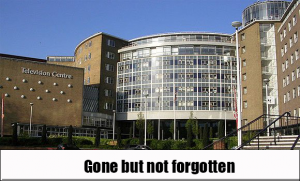 Gradually I noted that familiar names were no longer on the credits. Now you can’t even read the credits!
Gradually I noted that familiar names were no longer on the credits. Now you can’t even read the credits!
Time passed, aged parents to be looked after and eventually family who lived in
France persuaded us to make the move. So here we are in an old farm house in the
very rural Gers. We have been here for 10 years now. We have learned to live with
the down side – no Indian restaurants or fish & chips but the peace and quiet make up
for a lot.
So many people I would like to thank for their time and advice so freely given. Many
of them no longer with us, but I expect they are looking down and complaining about
lip sync, intrusive music and lousy presentatition. I hope that, in my turn, I managed to
pass on a few tips to the next generation of TCs. I was paired with Geoff Shaw for a long time and it was because he attracted such a wide range of shows that I learned so much. Thanks Geoff. Dave Jervis put up with me pushing him to create effects for Johnnie Stewart & TOTP. What a contrast to Peter Coe & Roger Davis with their mechanical wipes!
So hear endeth the story, so many memories and stories scattered around, still untold.
Is it a happy ending?Yes it is, I think I have had a very interesting and lucky life.
Perhaps I was right in starting with “Once Upon aTime”
{If there are any errors in this story please put it down to old age and keep quiet
about it! Cheers, Clive.}

